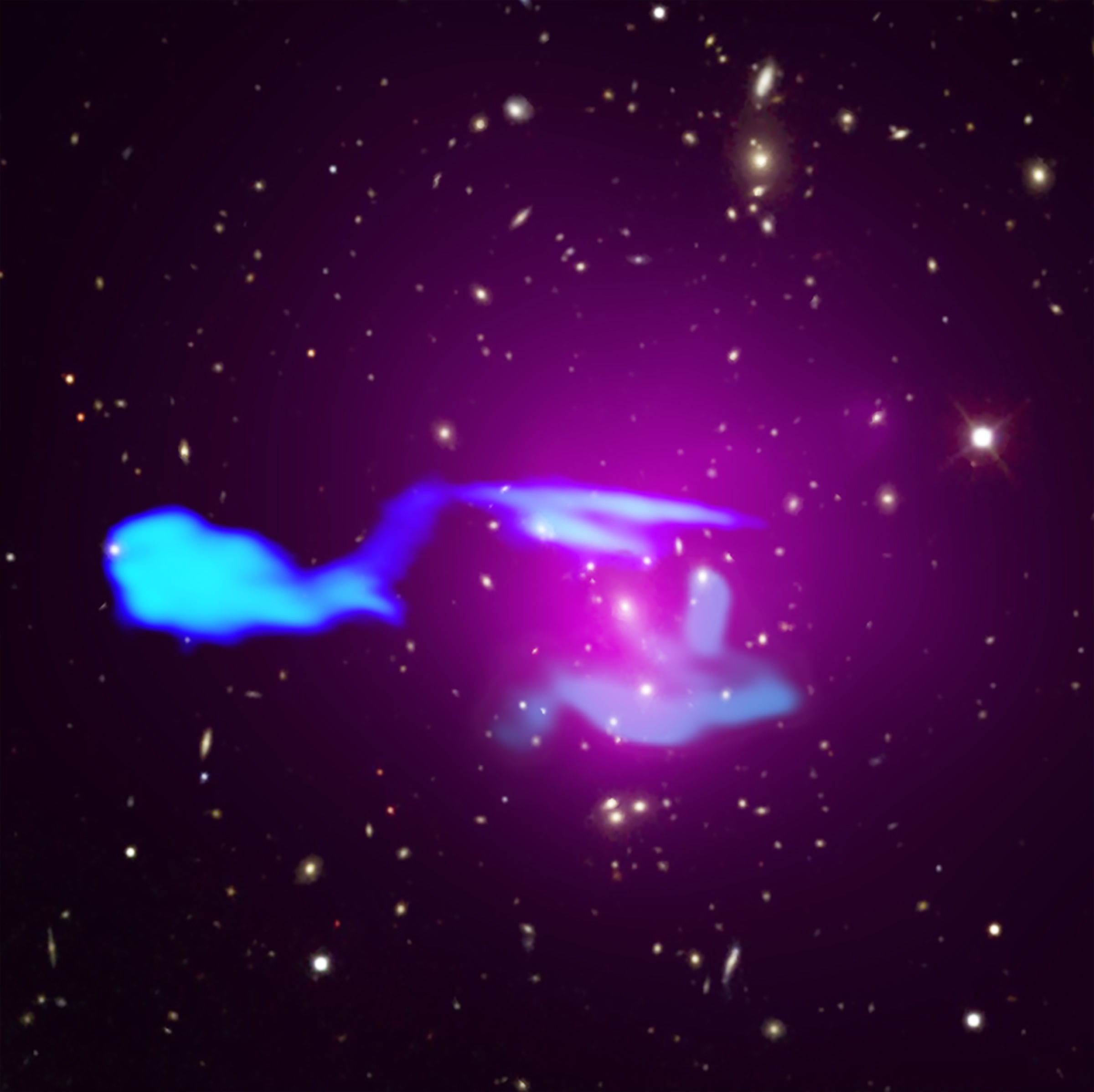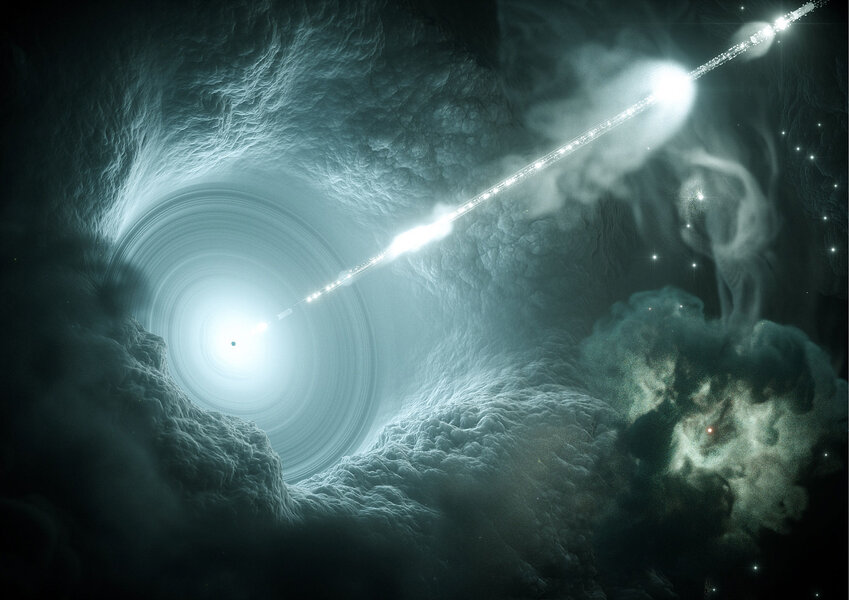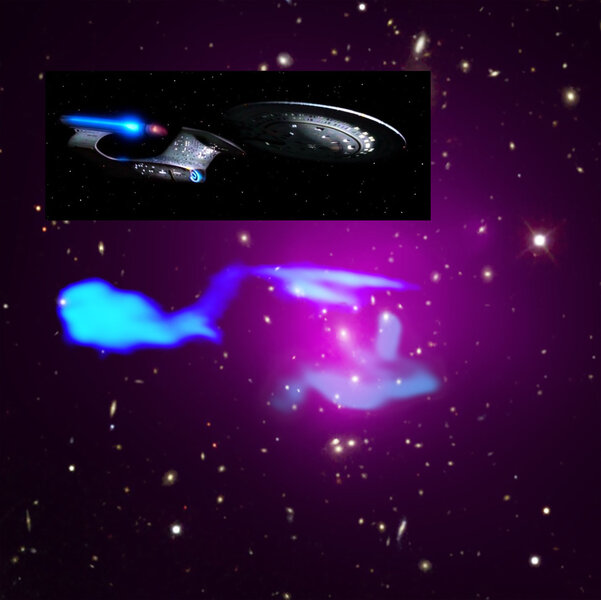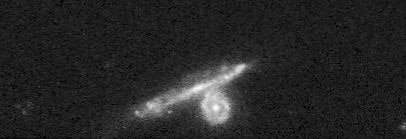Create a free profile to get unlimited access to exclusive videos, sweepstakes, and more!
Observing galaxy cluster collisions is quite the… enterprise

When it comes to cosmic train wrecks, it’s hard to imagine anything more colossal than the collision between galaxy clusters.
You have to understand: A galaxy is an immense thing. The Milky Way is 100,000 light years across — that’s about 1018 kilometers, or written out: 1,000,000,000,000,000,000. That’s a lot of zeroes. It also contains hundreds of billions of stars. It crushes my brain trying to grasp the scales here.
Yet a galaxy cluster is a collection of galaxies, hundreds or thousands (!!) of them, all moving around and held together by their mutual gravity. They swim through a miasma of thin, very hot gas called the intercluster medium, which is in general gas that’s been stripped from the member galaxies and heated by various methods to temperatures that get into millions of degrees. We can usually only see this gas because it emits X-rays, indicating how ridiculously hot it is.
Now take two of these soul-crushingly brobdingnagian objects and smash them together at, oh, say a few hundred kilometers per second and see what happens.
I can save you the trouble. What you get is Abell 1033, a collision between two galaxy clusters 1.6 billion light years away from Earth that contains a staggering 300 trillion times the mass of the Sun combined:
OK, this takes some explaining. You can see a lot of little fuzzy galaxies in the image; those are the member galaxies of the two clusters that are colliding. You see those in visible light (displayed as red/green/blue) in an image from the Sloan Digital Sky Survey. The purple background glow is the hot intercluster gas, taken using the Chandra X-Ray Observatory. The bright blue blobby clouds are gas observed using the Netherlands’ Low Frequency Array (or LOFAR) in low energy radio waves.
It’s those blue clouds that were the reason this image was taken. Think for a second of a balloon: It’s filled with gas. The tension in the rubber holds it together, and the pressure of the gas inflates it. The pressure is caused by how warm the air is, which tells you how the atoms are moving around. The warmer they are, the faster they jiggle, and the higher the pressure. The balloon inflates. Cool it and the jiggling slows down, the pressure drops, and the balloon deflates.
The same is true for that intercluster gas. It’s freakishly hot, and the electrons whipping around inside it generate the pressure. But there’s a problem: When you use a bunch of physics based on the temperature to measure the pressure inside, there’s too much. Something must be adding pressure to the gas that isn’t due to its temperature. We call those non-thermal processes, and they can include things like magnetic fields and other ways of energizing gas.
The astronomers took these images to try to figure out what those processes might be. That’s where the blue clouds come in. The big puffy end-of-a-Q-Tip-looking one on the left is connected to the two parallel smears in the middle. Those are radio beams and lobes, huge clouds of gas blown out by a galaxy in the cluster, distorted by the galaxy moving through the gas (the blue clouds on the lower right are from other galaxies and, while interesting, aren’t relevant to the discussion here).
In a nutshell — and as I’ve written about many many many many many many times before — every big galaxy has a black hole in its core. Matter falling into it piles up outside the Point of No Return in a flat disk called an accretion disk. This disk is unbelievably hot, and also has twisty magnetic field wrapped up in it. This all combines to focus a pair of beams of matter and energy that shoot out of the core, blasting into space at high speed. When it gets far enough outside the galaxy the gas expands, forming twin puffy lobes on opposite sides of the galaxy, sometimes hundreds of thousands of light years distant.
In general those beams are straight, but in this case the galaxy is moving, because we’re actually seeing two clusters colliding. As the galaxy moves through the gas, the beams get bent and the lobes kinda squashed.
Here’s the interesting thing: The two split smears are probably from one of the radio lobes getting pushed around by the gas surrounding it. Careful observations indicate the electrons in that gas are more energetic than in the other lobe on the left. The astronomers think that may be due to the gas being re-energized, probably due to turbulence in the intercluster gas (a natural outcome with all that hot stuff blowing around) or from shock waves. This keep the electrons pumped up with energy far longer than you’d expect; normally by now they’d cool and be lower energy like their counterparts in the other lobe. Note that the lobe on the left is not inside all that intercluster gas (the purple stuff, remember), so it’s been left to its own devices and is cooling more rapidly.
The astronomers think this may be one of the non-thermal processes keeping the gas pressure up inside the cluster. Nifty!
Now all this science is cool — I’ve never seen a radio lobe bent as catastrophically as the one here — but this story is getting a lot of press, and as awesome as non-thermal shock-driven radio lobe emission is to me, that’s probably not the case to everyone. So why the attention?
Because the radio emitting gas looks familiar. Does it to you? Here, this might help:
Yup. It’s the Big-E, ol’ NCC 1701-D, the USS Enterprise (I’ll note the Chandra page compares it to the TOS Enterprise, but come on, it’s clearly Picard’s ship). The resemblance isn’t bad, with the left lobe being the Stardrive section, and the more energetic lobe on the right the Saucer section. Seeing familiar shapes in random or semi-random things is called pareidolia, and I may have written about that a few times, too.
So of course nerds like me are enjoying the similarity. But I can’t leave this here without mentioning the greatest example of Trekeidolia of all time, and I’m not just saying that because it’s mine. I mean, seriously, open your hailing frequencies for this:
Those are two galaxies I happened to spot in a Hubble image taken using STIS, a camera I worked on for many years. I wrote up how that happened back on my old Bad Astronomy website, if you’re curious. But those are two disk galaxies, a small one face-on and a larger one edge-on, placed so perfectly from our point of view that the resemblance is just about perfect.
And hey, if you’re not a Trek fan that’s fine, but I think it’s pretty clear that the Universe itself is. And if I may paraphrase a good captain: “What is a person, but that lofty spirit, that sense of enterprise?”






























